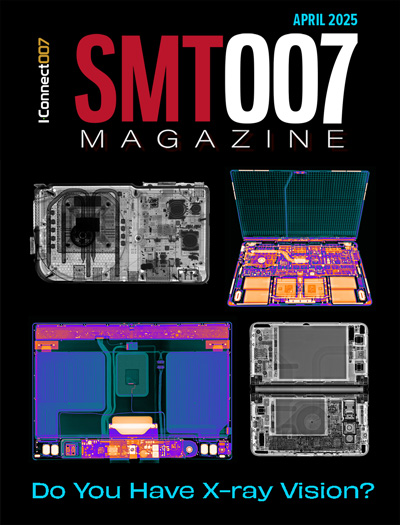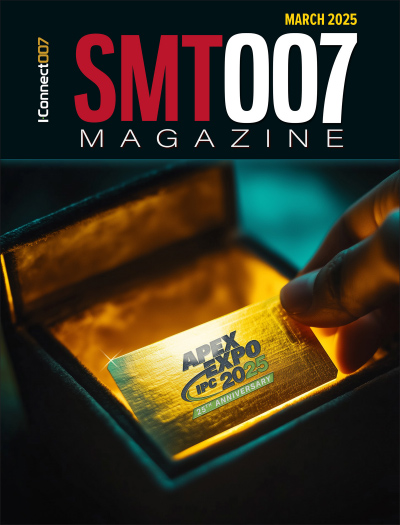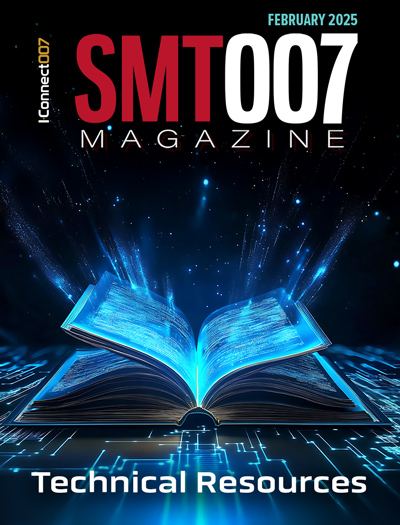-

- News
- Books
Featured Books
- smt007 Magazine
Latest Issues
Current Issue
Do You Have X-ray Vision?
Has X-ray’s time finally come in electronics manufacturing? Join us in this issue of SMT007 Magazine, where we answer this question and others to bring more efficiency to your bottom line.

IPC APEX EXPO 2025: A Preview
It’s that time again. If you’re going to Anaheim for IPC APEX EXPO 2025, we’ll see you there. In the meantime, consider this issue of SMT007 Magazine to be your golden ticket to planning the show.

Technical Resources
Key industry organizations–all with knowledge sharing as a part of their mission–share their technical repositories in this issue of SMT007 Magazine. Where can you find information critical to your work? Odds are, right here.
- Articles
- Columns
Search Console
- Links
- Media kit
||| MENU - smt007 Magazine
High Temperature Component Warpage as a Function of Moisture Sensitivity (MSL) Rating
May 29, 2024 | Neil Hubble, AkrometrixEstimated reading time: 2 minutes
Editor’s Note: This paper was originally published in the Proceedings of SMTA International, Rosemont, IL, September 22–26, 2019.
Background
Moisture sensitivity requirements for non-hermetic surface mount devices are defined in the joint IPC/JEDEC standard J-STD-020E, “Joint IPC/JEDEC Standard for Moisture/Reflow Sensitivity Classification for Non-hermetic Surface-Mount Devices,” last updated in December 2014.
This standard allows customers and suppliers to place electronics devices into specific categories, defined into 8 different moisture sensitivity levels (MSL). Test method criteria are defined within this standard to define MSL levels for different packages.
A subsection of MSLs are shown in Figure 1, showing the MSL 3 and 4 used in this study.
The absorption of moisture inside a package can cause vapor pressure within the package. In some cases, this vapor pressure can cause internal delamination of the internal components of the package, and in more extreme cases a “popcorning” effect on the sample surface. The popcorn effect would be seen by warpage analysis, but it isn’t clear whether lesser cases of internal delamination will play a role in warpage levels over reflow. Package warpage is generally accepted to be mainly driven by CTE mismatch between package materials, thus an additional force, such as vapor pressure, is expected to have some level of impact. However, the impact of vapor may not be statistically relevant and may be within the noise of measurement resolution and/or test variation.
One common method for identifying internal package delamination is scanning acoustic microscopy (SAM). This method can look inside a package for delamination. SAM, or C-SAM, is performed in water and is not used for behavior of a package through reflow temperatures.
A previous iNEMI study “Recent Trends of Package Warpage Characteristic,” also asked the question of relations between moisture exposure and warpage. However, this study was unable to find any statistically relevant relation between moisture exposure and warpage. Further studies related to MSL levels have also found that the length of a reflow profile can play a role in the effects of moisture exposure on reliability.
Component warpage is a well-established reliability and yield concern for electronics packaging. Multiple industry standards define allowable warpage levels and component testing best practices, including JEDEC JESD22-B112B, JEITA ED-7306, and IPC-7095D. These standards are used for testing approaches within this study, as well as data analysis.
Additionally, numerous published studies show the relationship between component thermal warpage and surface mount defects. These studies include such titles as, “Reflow Warpage Induced Interconnect Gaps between Package/PCB and PoP Top/Bottom Packages” and “Effect of Package Warpage and Composite CTE on Failure Modes in Board-Level Thermal Cycling”, to name a few.
Continue reading the rest of this white paper in the May 2024 Issue of SMT007 Magazine.
Suggested Items
Akrometrix LLC Reports a Record Year of Revenue for 2024
03/04/2025 | Akrometrix LLCAkrometrix, the global leader in Thermal Warpage Metrology, announces financial results for the full year 2024.
Akrometrix Announces 30 Year Anniversary as Industry Leader in Thermal Warpage Metrology
02/25/2025 | Akrometrix LLCAkrometrix is celebrating their 30 year anniversary as an industry leader in thermal warpage metrology. Professor Ifeanyi Charles Ume founded Akrometrix out of Georgia Tech 30 years ago to address issues in PCB flatness using the shadow moiré warpage measurement technique.
Book Excerpt: The Printed Circuit Assembler’s Guide to... Low-Temperature Soldering, Vol. 2, Chapter 5
12/23/2024 | I-Connect007 Editorial TeamChapter 5 introduces the advantages of using low-temperature soldering for through-hole components, including cost efficiency, reliability improvement, and reduced warpage. Also covered: the evaluation of different fluxes and the performance of HRL3 in wave soldering and selective soldering processes.
iNEMI HDI Socket Warpage Prediction and Characterization Webinar
11/15/2024 | iNEMIHigh-density interconnect (HDI) sockets, primarily designed for CPUs and GPUs, are shifting toward larger form factors as the number of interconnect pins increases.
DELO Introduces UV-approach for Fan-out Wafer-level Packaging
10/25/2024 | DELODELO has developed a new approach for fan-out wafer-level packaging (FOWLP). Its feasibility study shows: With the use of UV-curable molding materials instead of heat curing ones, warpage and die shift can be reduced significantly. Additionally, this leads to improvements in curing time and minimizes the energy consumption.


